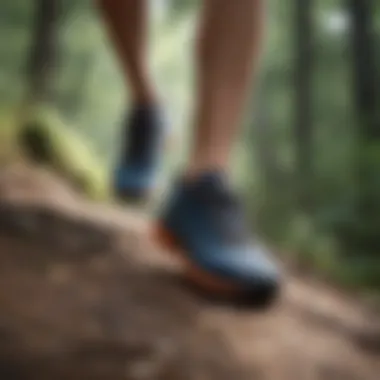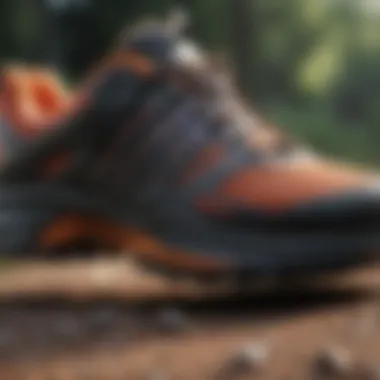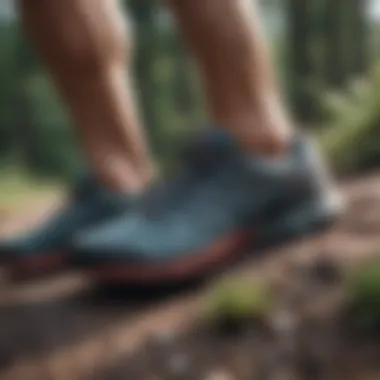Top Trail Running Shoes for Flat Feet Support


Intro
For those who have flat feet, finding the perfect footwear for trail running presents a set of unique challenges. This specialized segment of running not only requires shoes that fit well but also those that can support the foot’s arch—or lack thereof. Flat-footed runners often struggle with discomfort, instability, and a higher risk of injuries. It’s a complex blend of biomechanics and personal enjoyment we’re addressing here.
Key Benefits
The right trail running shoes can considerably enhance both physical health and mental well-being, which is especially critical for flat-footed individuals.
Physical Health Benefits
- Injury Prevention: Properly tailored trail runners help in reducing the risk of injuries like shin splints, plantar fasciitis, and knee pain that arise due to inadequate support. A shoe with a supportive structure can help redistribute weight and ease stress on joints.
- Enhanced Stability: A firm foundation is crucial when navigating uneven terrains. Shoes with a wider forefoot and a sturdy heel counter can prevent slips and falls, making it easier to focus on the trail rather than your footing.
- Comfort During Long Distances: When embarking on long runs, discomfort can quickly turn into a major distraction. Well-constructed shoes designed for flat feet ensure cushioning and support, allowing runners to focus on their endurance.
Mental Well-being Enhancements
- Satisfaction from Performance: There’s nothing like feeling comfortable while running. When your feet are happy, it elevates your mood and improves your performance.
- Connection with Nature: Trail running often lends itself to the serenity of the outdoors. Wearing reliable and well-fitting shoes allows you to immerse yourself fully in your surroundings, potentially relieving stress and boosting your spirit.
"Choosing the right footwear is not just about comfort; it’s about empowering your experience while trail running."
Practical Tips
Finding suitable trail runners designed for flat feet isn’t just a matter of personal preference; it’s essential for maximizing your trail experience. Here are some practical pointers for a wise selection process:
Understanding Key Features
- Arch Support: Look for shoes that come with built-in arch support or consider custom orthotics for added relief.
- Cushioning: Shoes should have ample cushioning to absorb impact during runs, lessening stress on the body.
- Stability and Motion Control: Features that enhance stability will go a long way in preventing foot roll and ensuring a firm grip on trails.
Trying Before You Buy
- Test During the Day: Shoe sizes can vary. Try them on later in the day when your feet are more likely to swell.
- Walk on Different Surfaces: If possible, test the shoes on various surfaces to assess grip and comfort.
Choosing the right trail running shoes is not just about aesthetics; it's fundamental for a positive and fulfilling trail experience. Being outfitted with the right gear encourages runners to push boundaries, discover new trails, and enjoy the process.
Understanding Flat Feet
Flat feet may sound trivial, but they carry significant implications for runners—especially those who prefer the ruggedness of trail running. Understanding flat feet lays the groundwork for appreciating the specific needs of flat-footed athletes. People often think of flat feet as merely a structural issue, but it possesses broader effects that reach into comfort, performance, and injury prevention.
Trail running is an exhilarating sport, but with flat feet, the right shoes aren't just important; they can make or break the experience. This section delves into the basic characteristics, causes, and implications of flat feet, setting the stage for how to choose suitable footwear.
What Are Flat Feet?
Flat feet, or pes planus, is a condition where the arches of the feet become so low that they don’t provide the usual support. Instead of a pronounced arch, the foot becomes nearly flat when standing or walking. This condition can be present from birth or can develop over time due to various factors like age or injury.
People may not even realize they have flat feet until they encounter pain or foot fatigue during activities such as running. The absence of a proper arch affects weight distribution along the foot, causing misalignments that ripple up into the knees, hips, and even the back.
Characteristics of Flat Feet
Several telltale signs indicate flat feet:
- Lack of Arch: When standing, the foot visibly flattens against the ground.
- Foot Pain: Over time, flat feet can lead to discomfort, particularly in the heel or arch regions.
- Uneven wear on footwear: Runners with flat feet may notice their shoes wear down more on the inner side.
- Increased Fatigue: More struggle to run or stand for long periods due to poor arch support.
Each of these characteristics can further complicate one’s running style, making it imperative to understand them fully.
Causes of Flat Feet
The reasons behind flat feet vary greatly and can include:
- Genetics: A family history of flat feet indicates a strong likelihood that it can run in families.
- Injury: Trauma to the foot, leading to weakened ligaments or structural changes, can contribute to the development of flat feet.
- Aging: With years, some people will experience a gradual loss of elasticity in foot ligaments.
- Conditions Such As Arthritis: Degenerative diseases can affect the structure of the foot itself.
Comprehending the causes of flat feet is crucial; it not only aids in coping with the condition but also equips individuals with the knowledge to take proactive measures for mitigating its impact.


"Understanding the mechanics of your feet can significantly improve how you run, especially on challenging terrains."
Whether one is running leisurely or pushing the limits on rugged trails, grasping the insights into flat feet opens new doors to improve performance and achieve a more satisfying running experience.
Running Mechanics for Flat Feet
Running mechanics play a pivotal role in understanding how flat feet impact overall performance and injury risk. The dynamics of motion, weight distribution, and foot strike are fundamental elements that define a runner's experience, especially for those with flat feet. Individuals with this condition often have a different way of moving, which can have both advantages and disadvantages. Grasping these mechanics is crucial not only for selecting the right footwear but also for improving running form, minimizing injury possibilities, and enhancing performance.
Impact on Running Style
Flat feet affect running style in several ways, often leading to noticeable changes in biomechanics. Unlike runners with higher arches, flat-footed runners don't have the same efficient arch to absorb shock. Instead, their feet lie flat against the ground, meaning less natural adaptability and shock absorption. When striking the ground, they tend to overpronate, or roll inward, as their feet seek stability. This can alter the alignment of the knees and hips, potentially leading to a chain reaction of musculoskeletal stress.
The overpronation seen in flat-footed runners can lead to a wider step when running, often described as a duck-like motion. This not only affects their running efficiency but also increases the risk of developing chronic issues over time, such as plantar fasciitis. It can also contribute to muscle fatigue sooner than in those with neutral or high arches. To counteract this, many benefit from biomechanical assessments to identify their unique running style.
A well-informed runner might prioritize certain styles of footwear that support a neutral alignment. Some might even consider integrating orthotics to minimize excessive motion and bolster stability.
Common Injuries
Flat feet are often linked to a variety of injuries prevalent in runners who don't adapt their biomechanics. Understanding these injuries can help in prevention and recovery. Key common injuries include:
- Plantar Fasciitis: This painful condition arises from inflammation of the plantar fascia, the band of tissue extending across the bottom of the foot. Runners with flat feet are particularly susceptible due to the excessive stretching and strain on this tissue.
- Achilles Tendinitis: With flat feet, the Achilles tendon must work harder. Increased strain can lead to inflammation, creating discomfort and limiting mobility.
- Shin Splints: Also known as medial tibial stress syndrome, shin splints can occur due to improper foot mechanics, placing undue stress on the shins.
- Knee Pain: Misalignment of the lower limbs because of excessive pronation can lead to knee pain, creating wear on the joints.
- Hip Issues: Flat feet can lead to compensation in the hip area, as the body adjusts to keep balance and alignment, potentially causing pain and dysfunction in the hips.
Proper awareness of these injury risks allows flat-footed runners to take preventive measures, such as specific strengthening exercises, stretching, and, importantly, wearing the right footwear designed to provide support and cushioning. Taking the proactive approach to adopt the correct practices not only enhances running comfort but can also keep injuries at bay.
Selecting Trail Running Shoes
Choosing the right trail running shoes is a significant, if not crucial, step for anyone who supports flat feet. Unlike shoes that cater to a neutral or high-arched foot, trail running shoes for flat-footers need to offer specific elements that keep the foot aligned and reduce the risk of injury. Understanding what makes a shoe suitable can make a world of difference in comfort and performance on rugged terrains.
When picking the right pair, consider factors that contribute to overall foot health. Features like arch support, cushioning, and stability can profoundly influence running efficiency and enjoyment.
Key Features to Consider
Arch Support
Arch support is perhaps the most critical aspect for those with flat feet. This feature helps maintain proper alignment of the foot and allows for a more natural running gait. The key characteristic of effective arch support is its ability to provide an upward elevation from the shoe's insole, which encourages your foot's natural arch to engage in a more optimal manner.
A unique feature of arch support in running shoes is the use of denser foam in the midsole. This density aids in constructing the stability needed during the push-off phase of your run. While many shoes boast arch support, not every model will accommodate the particular shape and needs of flat feet. A beneficial choice typically involves a shoe designed specifically with supportive elements strategically placed throughout the midsole, allowing for better control and less strain on the muscles of the lower leg.
Cushioning
Next up is cushioning. It plays a significant role in reducing the impact of each step taken on rugged paths. The key characteristic here lies in a balance; too little cushioning may lead to discomfort, while too much can sacrifice stability. For those with flat feet, optimal cushioning often comes from materials that absorb shock without compromising the foot’s overall support system.
A unique aspect of cushioning to consider is its variability. Different brands utilize various technologies to enhance cushioning, such as gel inserts or air pockets. These features not only absorb shock, but they also provide an energy-return mechanism, making each stride feel buoyant to some degree. However, excessive cushioning can lead to instability, particularly for flat-footed runners, leading to a less effective run and possibly causing injury if the foot rolls excessively inward.
Stability
Last but certainly not least, stability is pivotal when selecting trail running shoes. This feature ensures that the foot doesn’t roll inward too much—something flat-footed individuals can be prone to. The key characteristic of stability footwear is a wider base that helps support the foot.
What sets good stability shoes apart is the inclusion of technologies designed to limit excessive motion, such as medial posts or firmer materials on the inner side of the shoe. This helps guide the foot through its natural motion cycle and provides security on uneven terrain, reducing the risk of ankle sprains or other injuries associated with rolling. However, finding the right balance is crucial, as overly rigid shoes can also lead to discomfort during longer runs.
The Role of Fit and Sizing
The fit and sizing of trail running shoes cannot be overstated. First, a snug but comfortable fit is essential. Shoes that are too tight can create discomfort, while shoes that are too loose can lead to blisters and instability. A proper fit ensures that the foot is securely held in place, allowing for efficient energy transfer with every step.
It's common for runners to buy shoes that are a half-size larger, as feet tend to swell during a run. Consider trying shoes on towards the end of the day when your feet are their largest. Also, it's a good idea to test shoes while wearing the same type of socks you intend to run in, as this can significantly affect the overall fit.
Ultimately, selecting trail running shoes requires attention to detail, as each feature plays an integral role in ensuring a comfortable and effective trail running experience. By considering arch support, cushioning, and stability alongside fit, you can experience running in a new light—pain-free and filled with the joy of the trails.
Top Picks for Trail Runners


Finding the right trail running shoe is crucial, especially for individuals with flat feet. The right footwear not only supports the foot structure but also significantly reduces the risk of injuries. This section presents a selection of trail runners that excel in catering to the distinct needs of runners with flat feet. By focusing on specific features, including arch support, cushioning, and stability, readers can make informed decisions about which shoes may enhance their running experience.
Asics Gel-Kahana
Overview
The Asics Gel-Kahana offers a balanced blend of support and cushioning, specifically engineered for runners with flat feet. This shoe shines with its ample midsole system, which provides much-needed shock absorption. Its unique GEL technology effectively minimizes impact, which is particularly beneficial for those who experience discomfort from running on uneven trails. As a popular choice, the Gel-Kahana is recognized for its capacity to deliver reliability and comfort over long distances, making it an essential contender in this category.
Pros
One of the standout features of the Gel-Kahana is its dynamic duo of cushioning and stability. It's designed to accommodate varying foot widths, providing a snug fit for flat-footed runners. The shoe's strong traction also aids in navigating rocky terrains effortlessly, which boosts the confidence of the wearer on challenging trails. Its durability ensures that runners can rely on it for extended training periods without rapid wear.
Cons
However, some users might find the Gel-Kahana a bit heavier compared to other models. Its weight may not be appealing for those seeking a lightweight option for speedier runs. Additionally, while the arch support is generally good, there may be periods of adjustment for new wearers to truly appreciate it, as it can feel different than a traditional runner’s shoe.
Brooks Adrenaline GTS
Overview
Known for its stability and versatility, the Brooks Adrenaline GTS is another exceptional choice for flat-footed runners. This shoe is lauded for its GuideRails technology, which helps align the body in its natural motion. The Adrenaline GTS provides both cushioning and support, addressing the common issues faced by flat-footed runners effectively. Its ability To accommodate different foot shapes makes it a favored option among many.
Pros
One major advantage of the Adrenaline GTS is its ability to offer comfort during long runs. The responsive foam cushioning ensures minimal fatigue, allowing you to tackle those long-distance trails without your feet taking a beating. Additionally, its breathable mesh upper helps maintain a comfortable temperature, keeping feet cool on hot or humid days.
Cons
On the flip side, some users have found the shoe’s sizing to be inconsistent. While trying them on might solve this issue, purchasing online could potentially lead to fit problems. Furthermore, the support might not be enough for runners with severe flat feet who may require custom orthotics for optimized comfort.
Saucony Guide
Overview
The Saucony Guide is renowned for its amalgamation of cushioning and stability. This shoe is equipped with PWRRUN cushioning, which offers excellent shock absorption while ensuring responsiveness. The Guide is designed to offer a plush feel underfoot while also providing the necessary support that flat-footed runners seek. Its construction is lightweight, making it a viable option for those who prioritize speed.
Pros
A noteworthy aspect of the Guide is its comfortable fit, thanks to its adaptable upper that accommodates diverse foot shapes. The focus on stability makes it ideal for tackling unpredictable trail conditions, offering runners the confidence required when navigating tricky paths. Moreover, the shoe’s sturdy outsole enhances grip, making it easier to engage with various terrains.
Cons
Conversely, the durability of the upper material has received mixed reviews. Some users have expressed concerns regarding wear and tear after consistent use. Additionally, while the PWRRUN cushioning is appreciated, some might find it less plush than they desire, which could impact comfort during extended runs.
New Balance Fresh Foam Hierro
Overview
The New Balance Fresh Foam Hierro is designed with trail runners in mind and stands out due to its plush cushioning and rugged design. It features a unique Fresh Foam midsole that contours to the foot, providing excellent comfort on uneven surfaces. The tread pattern is aggressive, ensuring superior grip on various terrains, which is vital in trail running.
Pros
One key advantage is the shoe’s ability to handle wet and dry conditions, making it perfect for changing weather scenarios. The Hierro also has a spacious toe box that allows natural toe splay, which can enhance stability. Furthermore, it’s designed to absorb shock well, which is particularly beneficial for individuals prone to discomfort due to flat feet.
Cons
Despite its many benefits, the Hierro might be considered bulky by some users. As a result, it may not be the ideal option for runners looking for a super light shoe. Additionally, its price point may deter budget-conscious shoppers, as it tends to be on the higher end of the spectrum.
Hoka One One Stinson


Overview
The Hoka One One Stinson is characterized by its maximum cushioning philosophy. This shoe aims to provide great comfort without compromising stability. It’s built for runners who need extra support, particularly on rocky and uneven trails. The Stinson’s roomy fit and elevated midsole make it a pleasure for those with flat feet, ensuring a plush experience on long runs.
Pros
A standout feature of the Stinson is its excellent shock-absorbing properties. The thick midsole allows runners to effectively navigate through obstacles while maintaining comfort. Moreover, the shoe’s meta-rocker geometry encourages a smooth transition from heel to toe, which can be beneficial for runners looking to enhance their form.
Cons
Nevertheless, the added cushioning can make the shoe feel less responsive compared to lower-profile options, potentially hindering quicker pace runners. Furthermore, some individuals may find it challenging to get used to the Stinson due to its unique feel, which may require a transition period from traditional shoes.
User Reviews and Feedback
When it comes to selecting the right trail running shoes for flat feet, the significance of user reviews and feedback cannot be overstated. While expert opinions and specifications certainly have their merit, it’s the insights from everyday runners that often provide a clearer picture of a shoe's performance in real-world conditions. This section delves into why user experiences are fundamental in making an informed choice and how they can guide prospective buyers toward the best options available.
Importance of User Experiences
User experiences serve as a compass for navigating the multitude of options on the market. Here’s why they matter:
- Real-Life Performance: Unlike marketing materials that can sometimes paint an overly rosy picture, user reviews showcase how well a shoe performs over time on various trail conditions. They reveal if a shoe truly holds up against mud, rocks, and the unpredictable elements of nature.
- Durability Insights: Runners often share their thoughts on the longevity of their shoes. Information on how the materials withstand wear and tear provides valuable context. This context is particularly crucial for those with flat feet, as inadequate support can lead to rapid deterioration.
- Comfort Over Time: While a shoe might feel comfortable during a short stroll around the store, user feedback frequently covers how that comfort translates into miles on the trail. Users report on pressure points, blisters, and overall foot fatigue, giving potential buyers a rounded view of the shoe's comfort level during extended use.
- Fit Preferences: Fit can be subjective, and hearsay can help people decide on whether to size up, size down, or go with their usual fit. Many runners throw in tidbits about the width, toe box space, and heel cup, which are particularly relevant for flat-footed individuals who might require a bit more room or structure.
- Injury Prevention: Insights from those who share similar foot structures and running styles can be invaluable. Users often note if they’ve experienced fewer injuries after switching to a particular model, illuminating which shoes may offer that much-needed support for flat feet.
"A good pair of shoes can be the difference between a joy-filled run and a painful experience. User reviews highlight what works and what doesn’t, making your selection process smoother."
Best Practices for Trail Running with Flat Feet
When it comes to hitting the trails with flat feet, following certain practices can make a world of difference. It’s not just about slapping on a pair of shoes and running off into the sunset. Taking the time to understand the right routines can enhance your experience, minimize discomfort, and keep injuries at bay.
Flat feet, due to their structure, require more careful consideration in terms of support and stability. Adopting best practices for trail running can bolster one’s confidence, allowing for better performance and enjoyment.
Warm-Up and Cool-Down Routines
A proper warm-up is crucial for everyone, but especially for runners with flat feet. Think of it as a gentle nudge to your muscles, getting them prepped for the upcoming action. Getting those legs moving before embarking on a run warms up the joints and raises the heart rate, both key in preventing injuries.
- Dynamic stretching: Before any trail run, consider incorporating dynamic stretches. Focus on your calves, quads, and hamstrings. Things like leg swings, high knees, or walking lunges can work wonders.
- Joint mobility: Don’t forget about those ankles! Performing ankle circles and flexes can help improve range of motion, which is particularly helpful for flat-footed runners.
- Specific drills: Try adding short strides or high-knee runs for about 5 to 10 minutes. This activity not only increases blood flow but also primes your body for the specific demands of trail running.
After your run, don't skip out on a cool-down. This helps your body transition back to a resting state, lowering the heart rate systematically and easing muscle tension.
- Static stretches: Focus on major muscle groups. Hold stretches for at least 20-30 seconds to effectively lengthen those muscles.
- Foam rolling: This can be a lifesaver, loosening up muscle knots and improving blood flow.
"A good warm-up and cool-down routine is as essential as wearing the right shoes. It sets the tone for your run and aids in recovery."
Incorporating Strength Training
Strength training is a game changer. While many may think it's reserved for the gym, it has fundamental ties to improving overall running dynamics. Runners with flat feet often exhibit overpronation—a tendency for the foot to roll inward too much during running. This can lead to discomfort and injuries. By enhancing muscle strength, you can minimize this risk.
- Focus on the feet: Strengthening the intrinsic muscles of the foot can help create better arch support. Movements such as toe curls or towel scrunches are simple yet effective.
- Leg and core work: Incorporate squats, lunges, and deadlifts into your routine. These exercises not only build muscle but also enhance balance and stability on uneven terrain.
- Hip strength: Strong hips are essential for a steady gait. Exercises like clamshells or lateral band walks help strengthen these critical areas, potentially reducing the risk of injuries common to flat-footed runners.
Incorporating these elements into your training will not only assist with performance but also cultivate a healthier stride. Running is as much about preparedness as it is about skill. The more balanced your body is, the more enjoyable your trail running experience will be.
End
In summing up the intricate relationship between flat feet and trail running shoes, it's clear that selecting the right footwear is not just a matter of comfort; it’s about ensuring optimal performance and reducing the risk of injuries. Flat-footed runners have unique biomechanical needs that necessitate careful consideration of shoe features, such as arch support, cushioning, and stability. Choosing wisely can help in managing common issues such as overpronation, which tends to plague flat-footed runners.
Benefits of Proper Shoe Selection:
- Enhanced Performance: A good pair of trail running shoes can make a world of difference in how efficiently you run. Supportive shoes help distribute weight evenly, allowing for better energy conservation over longer distances.
- Injury Prevention: With the right cushioning and support, one significantly reduces the likelihood of injuries like plantar fasciitis or shin splints—a common plight for those with flat feet.
- Increased Enjoyment in Running: Comfort goes a long way in fueling one’s love for running. When you’re pain-free and well-supported, you’re more likely to enjoy the trail, encouraging longer and more fulfilling runs.
Considerations Moving Forward:
It’s not enough just to acquire a good pair; proper fitting is paramount. Runners should consider factors such as the type of socks they wear and how the shoe adapts to their unique foot shape. For those embarking on their trail-running journey with flat feet, it’s wise to consult with professionals or visit specialty stores where knowledgeable staff can help guide them through their options.
Ultimately, the right trail running shoes for flat feet aren’t just about aesthetics or brand names—they are a critical investment in a runner’s overall health and happiness on the trail. With the ample knowledge and resource infrastructure available today, flat-footed runners are well-positioned to find the perfect pair that will allow them to hit the trails with confidence.
"Supportive shoes are not just a luxury—they're a necessity for flat-footed runners to keep injury at bay and joy in running alive."
As diverse as the trails we run on, so too are the options available for supportive running shoes. Evaluating all the available choices through this lens of practicality will reward runners not only in terms of performance but also in enjoyment of their trail experience.















